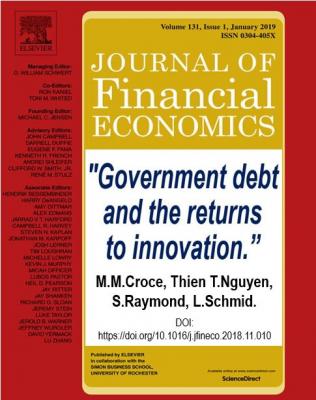New research shows that tinkering with public debt is bad for innovative firms. In other words, if the public debt grows, the outlook for innovative firms suffers. Subsequently, GDP growth declines at a later date. This is what four researchers wrote in the Journal of Financial Economics (citation below).
Most of us already know that budget consolidations after surges in government debt undermine long-term growth. Political uncertainty, high tax pressure, and rising inflation are not good for the economy.
This new study found that growing public debt affects GDP growth negatively also because it hinders investment. Especially, investment in innovative firms.
Co-author, Max Croce, Professor of Finance at Bocconi University in Milan, Italy, said.
“By affecting their cost of capital, movements in government debt impact firms’ investment and, critically, innovation decisions.”
An innovative firm is a business that has implemented or is about to implement innovation. Innovation involves creating, inventing, and producing new goods, services, process methods, or business models.

Innovative firms – exposure to fiscal variables
The authors gathered and analyzed data on 6,000 firms in the USA from 1975 to 2013. They found that about one-third of the premium that innovative companies must pay their investors depends on the exposure to fiscal variables. This proportion is much higher than for run-of-the-mill businesses.
Prof. Croce said:
“This spread is huge, at around 7.5% per year, and it could decline to 5% if there were no fiscal uncertainty.”
When public debt is growing, interest rate spikes and uncertainty regarding future fiscal pressure make future cash flow less predictable. Additionally, investors and managers become cautious.
When they have to decide which projects to back financially, they choose the safest and most profitable ones. Riskier projects, on the other hand, are more likely to be avoided.
The net result is that four or five years later, GDP growth declines. This is due to a lack of innovation starts that affect the overall economy.
A public debt of 100% results in a 4% GDP decline after five years compared to a 60% public debt. The authors refer to the 60% public debt as the ‘normal’ one.
What’s best for innovative firms?
Prof. Croce said:
“Our results mean that a policy of `prudential austerity,’ that is, a commitment to reduce public debt during good economic times paired with fiscal policies that prevent long-run tax uncertainty, could be the most effective.”
“On the one hand, a systematic use of budget deficits undermines growth and, on the other, indebted countries risk to experience down cycles with no leeway for fiscal stimuli.”
Citation
“Government debt and the returns to innovation,” M.M.Croce, Thien T.Nguyen, S.Raymond, L.Schmid. Journal of Financial Economics. DOI: https://doi.org/10.1016/j.jfineco.2018.11.010.

